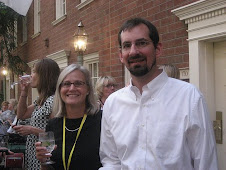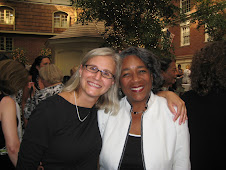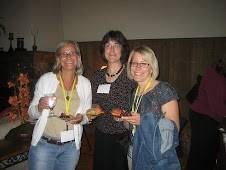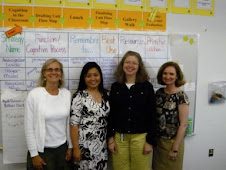As I reflect on the week in Albany, so many new ideas have filled my personal frame of reference. Below is Jackie’s Top Ten List of NUA Summer Academy 2008 Highlights. I know that I am missing a ton of memorable moments, so I’d love to hear from you regarding what's in your frame. Simply click “comments” below this post if you would like to share your reflections and highlights. The blog comments section allows for an online dialogue of sorts, and I have used the comments feature with my students to continue a discussion on a certain topic.
Jackie’s Top Ten List
David Hyerle: David’s work has such a direct impact on my daily classroom instruction that I was honored to get the chance to talk with him at length on Wednesday night. Over the years my head has been filled with a list of questions that I would ask David if I ever got the chance, and I finally got that chance. Not only did the conversation with David provide me with a deeper understanding of the knowledge structures behind Thinking Maps, but also I was able to formulate a new game plan for promoting the use of Thinking Maps with my students and teachers. Thanks David for that great opportunity. You really were the WOW of my week.
Jackie’s Top Ten List
David Hyerle: David’s work has such a direct impact on my daily classroom instruction that I was honored to get the chance to talk with him at length on Wednesday night. Over the years my head has been filled with a list of questions that I would ask David if I ever got the chance, and I finally got that chance. Not only did the conversation with David provide me with a deeper understanding of the knowledge structures behind Thinking Maps, but also I was able to formulate a new game plan for promoting the use of Thinking Maps with my students and teachers. Thanks David for that great opportunity. You really were the WOW of my week.

Eric Cooper: My frame includes Eric as the spiritual center of NUA. Eric’s enthusiasm and beliefs that education is a civil right, and that when we teach for justice, we can really make a difference in people’s lives provide the energy that I need when I am bombarded daily with negative messages about public education. Eric reminded me of the power of positive thinking, and he really made me feel at home with NUA. Whenever I am feeling down at school, I can just think to myself, "What would Eric say?"

Yvette Jackson: When I reviewed my notebook entries from the past week at Summer Academy, I realized that Yvette and her ideas were everywhere. No wonder she is one of the main voices that runs through my head. I know that I will share Yvette’s triangle of fluency, construction and communication with my staff as a way of looking at literacy and high intellectual performance. Also, thanks Yvette for sharing Eliot Eisner's definition of literacy as “constructing, communicating, and creating meaning in many forms of representation.” I plan to use that quotation with my staff as a means into a conversation that all teachers use text and are literacy teachers.

Denise Nessel: Although I neglected to give credit to one of the inspiring influences for my creation of this Edina NUA blog during my presentation during the NUA Summer Academy, I really have to credit Denise Nessel for that spark. On the final day of last year’s NUA Summer Academy, Denise approached me after the Edina presentation and told me to consider capturing coaching stories and to consider writing a book about my experiences as a part-time classroom teacher and part-time NUA coach. Denise’s idea to capture my coaching notes was one of the early sparks for the blog. Besides being one of the blog inspirations, Denise's strategies have a profound impact on my classroom.

Evelyn Rothstein: The always entertaining and educational Evelyn Rothstein was back again this summer. Since Year 2’s didn’t have an Evelyn presentation on our agenda, some of us cornered her for private audiences. Nguyen, Deb, Kelly and I enjoyed her definition of cultural universals during a conference with Evelyn about our staff development plan. And Evelyn shared her personal story of getting her first teaching license in New York with a small audience of WMEP teachers. Thanks Evelyn for all of your cultural insights.

LaVerne Flowers: Although LaVerne was often in the background during workshop sessions this week, I always draw inspiration and security from her presence. LaVerne has been my key connection to NUA over the last five years, and she has had a huge influence on my confidence and competence as a teacher and coach over the years. Without LaVerne pushing me to be even better, I would not be the teacher and coach that I am today.

Frame of Reference: The frame became a common theme of the week, even getting its own hand gesture, and the insights gained from frame discussions will carry over to my classroom and staff development activities this fall. I am especially excited to try out the simultaneous frame on Thinking Maps to get teachers and students to listen to the voices in their head, an idea taken from David Hyerle’s session with Year 2 participants on Wednesday afternoon.
Networking: Collaboration and networking with people from other school districts is a great component of the summer academy. WMEP networking highlights for me this year include my usual breakfast talk with Wayzata educators, sitting with and sharing ideas with Karin, Shelby and Andrew from Hopkins during most of the sessions, Edina Year 1’s adopting Terri from Robbinsdale, and my Friday night spent in Chicago with Dominic, Beth, and Lisa from Eden Prairie. (United Airlines put us up at The Westin when our connecting flight to Minneapolis was cancelled since our plane from Albany landed shortly after a Mexican Airlines plan skidded off the runway at O’Hare.) Besides connecting with WMEP folks, another collaboration highlight of the week was the Edina Year 2’s working with Melissa and Peg from Albany on our taxonomy presentation with the serve it up, bump, set, spike, everybody rotate method of presentation. Peg and I left the week vowing to keep in touch.




Creating Staff Development Plans: During district meeting time and Year 2 planning time for a staff development seminar, I was able to take home plans that I can immediately begin implementing to promote culturally responsive strategies in Edina Public Schools. Nguyen, Kelly, Deb and I used the pedagogical flow map to finalize a seminar plan for our before school workshop week. And thanks to Carlton Long for giving us some great ideas for text from Jabari Mahiri to use with our seminar plan.

Music: From songs created in skits to formal gatherings, music energized the week. Eyka leading The Cupid Shuffle woke me up after dinner, and the NUA Trio with Stefanie’s lead vocals for Lean on Me was a fitting send off for the week. An outstanding find of the week was Jeremy Dudley and his original rap. Jeremy’s performance at the talent show Friday was so exciting that I have already ordered his CD from http://www.originalrap.com/.

Thanks to everyone for making family reunion week (Nanette's metaphor), aka NUA Summer Academy 2008, an enlightening and energizing experience. Also, thanks to the Edina adminstration for supporting our efforts at NUA. Thanks Jeff for sharing all of the photos online so that I could post a few.









